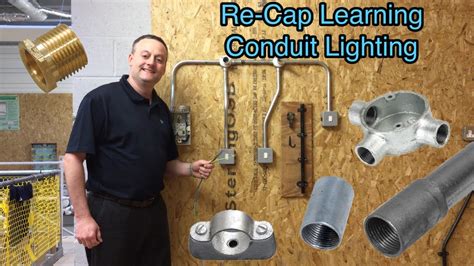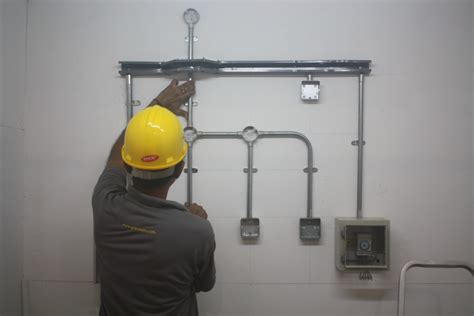bring metal flexiblr conduit to box Connecting flex conduit to a junction box is a crucial step when it comes to electrical installations. Flex conduit, also known as flexible metallic conduit (FMC) or greenfield, provides a protective housing for electrical wires .
ENERLITES Weatherproof Outlet Box with Three 3/4-in Threaded Outlets, Outdoor Electrical Box, 3 Holes 0.75” Each, 1-Gang, 4.57” Height x 2.83” Length x 2.05” Depth, EN1375
0 · metal conduit installation problems
1 · metal conduit in work box
2 · flexible conduit to drywall
3 · flexible conduit for work boxes
4 · flex conduit to electrical box
5 · electrical box conduit connector
6 · connecting flexible conduit to electrical
7 · connecting flexible conduit to box
Adoorn’s lockable, weatherproof Post Mount-Large mailbox keeps your mail secure. It’s simple for mail carriers to use & easy for you to access using your key. Choose from a variety of colors to add a unique pop to your home. External Dims: .
Most electrical codes permit fishing a length of flexible conduit into a finished wall, but the problem always has been how to connect the connector easily to an old work [.] The first step in connecting flexible conduit to an electrical box is to select the appropriate size of locknut and bushing based on the diameter of the conduit. Once you have . When one is using a flex-conduit fitting (like shown in the picture below) to connect to a metal single-gang outdoor box (also shown below), what keeps the threaded fitting secured inside the metal box threads? Is it just a . I ran some flex metal conduit through a short, difficult section of basement to rigid PVC in a garage, with adapters from one to the other. There was some discussion as to whether it was code-compliant, as I believe.
ENT conduit (the plastic stuff with ridges) and I'm connecting that to a single gang metal box, the type where you remove the tab with pliers or a screwdriver to clamp NMD. How do you connect the flex conduit to that? The . Connecting flex conduit to a junction box is a crucial step when it comes to electrical installations. Flex conduit, also known as flexible metallic conduit (FMC) or greenfield, provides a protective housing for electrical wires .
The essential steps for connecting conduit to a box include measuring and cutting the conduit to the required length, removing any burrs or sharp edges, inserting the conduit into the box, securing it in place, and . My question is how to clamp/attach this conduit whip to the existing metal ceiling junction box from inside of the box and to avoid tearing up the drywall ceiling. I was only able .
metal conduit installation problems

The simplest way to do this would be to use an EMT-to-FMC coupling and a length of flexible metal conduit of the same size as your EMT that "dives" into the wall and lands in a straight-in FMC fitting atop the panel, as it . Once you have the connector attached securely to the end of the flexible electrical conduit, it is time to attach the connector to your electrical box. First, you need to punch out the desired knockout hole on the electrical box. To do this, simply use a screwdriver to pop out the metal disc filling the space for the connector. Most electrical codes permit fishing a length of flexible conduit into a finished wall, but the problem always has been how to connect the connector easily to an old work [.]
The first step in connecting flexible conduit to an electrical box is to select the appropriate size of locknut and bushing based on the diameter of the conduit. Once you have selected these components, insert the conduit into the electrical box and tighten it with a locknut.
When one is using a flex-conduit fitting (like shown in the picture below) to connect to a metal single-gang outdoor box (also shown below), what keeps the threaded fitting secured inside the metal box threads? Is it just a friction fit against the rubber O-ring or is there a backing nut as shown on the fitting? I ran some flex metal conduit through a short, difficult section of basement to rigid PVC in a garage, with adapters from one to the other. There was some discussion as to whether it was code-compliant, as I believe. ENT conduit (the plastic stuff with ridges) and I'm connecting that to a single gang metal box, the type where you remove the tab with pliers or a screwdriver to clamp NMD. How do you connect the flex conduit to that? The only flex conduit connectors I can find are circular. Connecting flex conduit to a junction box is a crucial step when it comes to electrical installations. Flex conduit, also known as flexible metallic conduit (FMC) or greenfield, provides a protective housing for electrical wires and cables.
The essential steps for connecting conduit to a box include measuring and cutting the conduit to the required length, removing any burrs or sharp edges, inserting the conduit into the box, securing it in place, and making sure the connection is tight and secure. My question is how to clamp/attach this conduit whip to the existing metal ceiling junction box from inside of the box and to avoid tearing up the drywall ceiling. I was only able to knock out what I think is a 1in knockout from inside the box. The simplest way to do this would be to use an EMT-to-FMC coupling and a length of flexible metal conduit of the same size as your EMT that "dives" into the wall and lands in a straight-in FMC fitting atop the panel, as it appears you have enough length in .
Once you have the connector attached securely to the end of the flexible electrical conduit, it is time to attach the connector to your electrical box. First, you need to punch out the desired knockout hole on the electrical box. To do this, simply use a screwdriver to pop out the metal disc filling the space for the connector. Most electrical codes permit fishing a length of flexible conduit into a finished wall, but the problem always has been how to connect the connector easily to an old work [.] The first step in connecting flexible conduit to an electrical box is to select the appropriate size of locknut and bushing based on the diameter of the conduit. Once you have selected these components, insert the conduit into the electrical box and tighten it with a locknut.
When one is using a flex-conduit fitting (like shown in the picture below) to connect to a metal single-gang outdoor box (also shown below), what keeps the threaded fitting secured inside the metal box threads? Is it just a friction fit against the rubber O-ring or is there a backing nut as shown on the fitting?
I ran some flex metal conduit through a short, difficult section of basement to rigid PVC in a garage, with adapters from one to the other. There was some discussion as to whether it was code-compliant, as I believe.
ENT conduit (the plastic stuff with ridges) and I'm connecting that to a single gang metal box, the type where you remove the tab with pliers or a screwdriver to clamp NMD. How do you connect the flex conduit to that? The only flex conduit connectors I can find are circular. Connecting flex conduit to a junction box is a crucial step when it comes to electrical installations. Flex conduit, also known as flexible metallic conduit (FMC) or greenfield, provides a protective housing for electrical wires and cables. The essential steps for connecting conduit to a box include measuring and cutting the conduit to the required length, removing any burrs or sharp edges, inserting the conduit into the box, securing it in place, and making sure the connection is tight and secure.
My question is how to clamp/attach this conduit whip to the existing metal ceiling junction box from inside of the box and to avoid tearing up the drywall ceiling. I was only able to knock out what I think is a 1in knockout from inside the box.
metal conduit in work box

cnc machine tynbrow
flexible conduit to drywall
ZombieBox is a portable, weatherproof, noise reducing enclosure for portable and standby generators, compressors, industrial equipment, electronic, medical and laboratory equipment.
bring metal flexiblr conduit to box|flexible conduit for work boxes